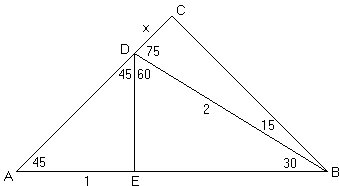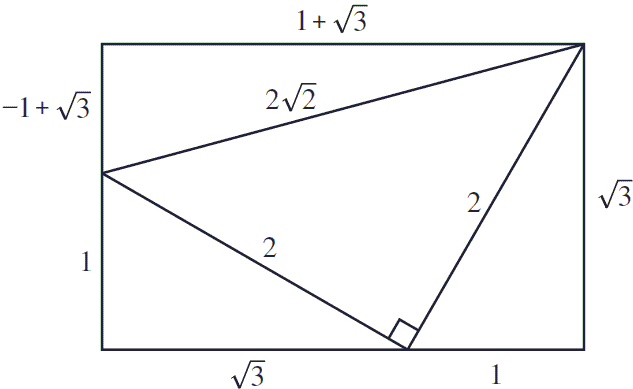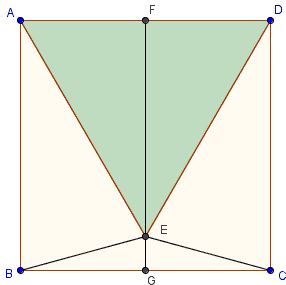Sine and Cosine of 15 Degrees Angle
The purpose of this page is to find in closed form values of sine and cosine of the $15^\circ$ angle. Our investigation will be based on the following diagram, which [R. Vakil, p. 97] attributes to Larry Hoehn:

We can place side by side the right isosceles triangle $ADE$ and the $30-60-90$ triangle $BDE$ and then extend $AD$ to $C$ to form another $45-45-90$ triangle $ABC.$ For convenience, we assume that $AE = 1.$ In $\Delta BCD,$ $\angle CBD = 15^\circ.$ This is the triangle whose sides we are hunting.
In $\Delta ADE,$ $DE = 1$ and, by the Pythagorean theorem, $AD = \sqrt{2}.$
In $\Delta BDE,$ $DE = 1$ and $\angle DBE = 30^\circ$ so that $BD = 2$ and $BE=\sqrt{3}.$
In $\Delta ABC,$ $AB = 1 + \sqrt{3}$ so that $AC = BC = (1 + \sqrt{3}) / \sqrt{2}:$
$\displaystyle AC = BC = \frac{\sqrt{2}+\sqrt{6}}{2}.$
Letting $CD=x,$ $AC=\sqrt{2}+x,$ which gives
$\begin{align}\displaystyle x &= \frac{(\sqrt{2}+\sqrt{6})}{2}-\sqrt{2}\\ &=\frac{\sqrt{6}-\sqrt{2}}{2}. \end{align}$
Since $\sin 15^\circ = CD/BD = x/2,$ it follows that
$\displaystyle \sin 15^\circ = \frac{\sqrt{6} - \sqrt{2}}{4}.$
Next, from $BC = (\sqrt{2} + \sqrt{6}) / 2$ and $\cos 15\circ = BC/BD:$
$\displaystyle \cos 15^\circ = \frac{\sqrt{6} + \sqrt{2}}{4}.$
It is reassuring that the values for the sine and cosine of $15^\circ$ fit into the double argument formula $\sin 2\alpha = 2 \sin\alpha\cos\alpha:$
$\displaystyle \begin{align} 2\sin 15^\circ cos 15^\circ &= [(\sqrt{6} - \sqrt{2}) / 4] \times [(\sqrt{6} + \sqrt{2}) / 4]\\ &= 2 (6 - 2) / 16 \\ &= 1 / 2 \\ &= \sin 30^\circ. \end{align}$
For the record, we can also deliver the tangent:
$\tan 15^\circ = 2 - \sqrt{3}.$
Here's another diagram that also offers a way of finding the values of trigonometric function for $15^\circ:$

The values of the trigonometric functions provide a way of establishing that $\angle CBE$ in the diagram below is $15^\circ.$

Here $ABCD$ is a square and $ADE$ an equilateral triangle. Indeed, assuming the side of the square equals $1,$ the altitude $EF$ of $\Delta ADE$ is found to be $\displaystyle\frac{\sqrt{3}}{2},$ from which $\displaystyle EG=1-\frac{\sqrt{3}}{2},$ making
$\displaystyle\tan GBE=\frac{EG}{BG}=\frac{1-\sqrt{3}/{2}}{1/2}=2-\sqrt{3}=\tan 15^\circ,$
as we just saw. It follows that $\angle CBE=15^\circ.$
We could have found that without recourse to trigonometry: $AE=AD=AB,$ which makes $\Delta ABE$ isosceles. Its apex
$\angle BAE=\angle BAD-\angle EAD = 90^\circ-60^\circ=30^\circ,$
making its base $\angle ABE=(180^\circ-30^\circ)/2=75^\circ.$ Its complementary $\angle CBE=15^\circ.$ Thus we would have an additional venue for finding the values of the trigonometric functions of $15^\circ.$
Reference
- D. S. Ailles, Triangles and trigonometry, Mathematics Teacher 64 (1971) 562
- R. Vakil, A Mathematical Mosaic, Brendan Kelly Publishing, 2008 (Expanded Edition)
Trigonometry
- What Is Trigonometry?
- Addition and Subtraction Formulas for Sine and Cosine
- The Law of Cosines (Cosine Rule)
- Cosine of 36 degrees
- Tangent of 22.5o - Proof Wthout Words
- Sine and Cosine of 15 Degrees Angle
- Sine, Cosine, and Ptolemy's Theorem
- arctan(1) + arctan(2) + arctan(3) = π
- Trigonometry by Watching
- arctan(1/2) + arctan(1/3) = arctan(1)
- Morley's Miracle
- Napoleon's Theorem
- A Trigonometric Solution to a Difficult Sangaku Problem
- Trigonometric Form of Complex Numbers
- Derivatives of Sine and Cosine
- ΔABC is right iff sin²A + sin²B + sin²C = 2
- Advanced Identities
- Hunting Right Angles
- Point on Bisector in Right Angle
- Trigonometric Identities with Arctangents
- The Concurrency of the Altitudes in a Triangle - Trigonometric Proof
- Butterfly Trigonometry
- Binet's Formula with Cosines
- Another Face and Proof of a Trigonometric Identity
- cos/sin inequality
- On the Intersection of kx and |sin(x)|
- Cevians And Semicircles
- Double and Half Angle Formulas
- A Nice Trig Formula
- Another Golden Ratio in Semicircle
- Leo Giugiuc's Trigonometric Lemma
- Another Property of Points on Incircle
- Much from Little
- The Law of Cosines and the Law of Sines Are Equivalent
- Wonderful Trigonometry In Equilateral Triangle
- A Trigonometric Observation in Right Triangle
- A Quick Proof of cos(pi/7)cos(2.pi/7)cos(3.pi/7)=1/8
|Contact| |Front page| |Contents| |Algebra| |Geometry|
Copyright © 1996-2018 Alexander Bogomolny73576386
